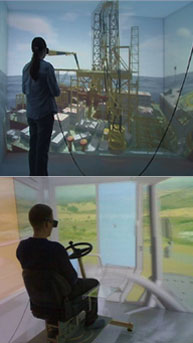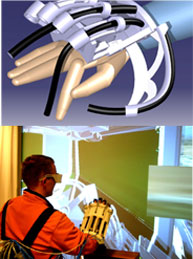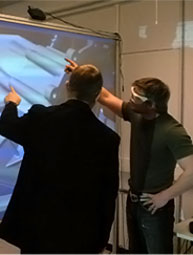|
|
 |
 |
 |
 |
| Research at Tampere University of Technology focuses on improvement of design methods in mechanical engineering using virtual environments (VE) and applying 3D interaction techniques such as haptics. |
|
 |
| Importing CAD Models into VE Framework |
 |
|
 |
Evaluating virtual prototypes in VE differs dramatically from traditional desktop visualizing. By the means of head tracking and stereographic displays it is actually possible to step inside the 3D model and watch detail in natural size.
Design work is mainly performed using 3D CAD software. However, such models need some preprocessing before they are ready for real-time visualization in VE. In addition, importing CAD models to VE framework is problematic because no native CAD format is supported in VE. Some well prepared conversion paths are found for CAD programs used by cooperation partners in this project. Problems related to CAD format conversion consists of lose of hierarchy, variation between scales and coordinates, modifications of texture and material setups.
In addition to stationary visualization, the models can also include functionalities. This means that user can interact with the model, for example, open doors and push buttons. In addition, the model can be interacted by external simulator enabling computer game – like user interfaces. |
|
 |
| |
 |
| Multimodal Interaction in Engineering Design |
 |
 |
Evaluating complex design (such as cockpits) based on visual sense only is demanding. We have developed tactile feedback devices, such as a haptic glove which enable user to feel panels and switches. This wearable haptic glove which is based on McKibben actuators enables user’s unlimited movement in VE.
Interaction in 3D VE with traditional 2D menus and pointing devices is awkward, disturbs working in VE and reduces immersion. We have studied multimodal interaction such as speech and gesture control which simplify the work in 3D VE.
|
|
| |
 |
Development of Design Process Using VE
|
 |
 |
Evaluation of virtual prototypes in VE makes it possible to employ user-centered design methods already in early conceptual design phase. These methods enhance understanding of customer needs and work practices. As a result, highly customized and user-friendly products can be constructed.
In addition, improved sharing of design information inside the product development team will intensify the product development process.
Usually test persons are first time in VE and they suffer easily from negative effects of VE (such as simulator sickness). Therefore we studied user-experience in the case of occasional user to improve testing taking place in VE. |
|
| |
 |
 |
|
